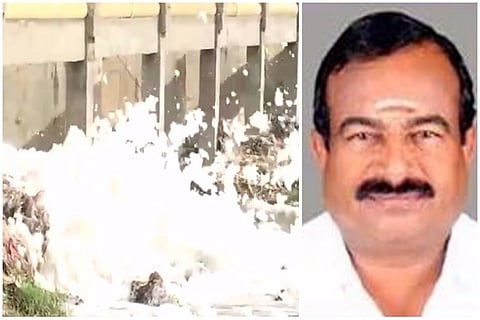

We’ve seen toxic foam spilling out of lakes such as Bellandur and Varthur in Bengaluru. Froth has bubbled over the Ramakrishnapuram Lake in Hyderabad. The ‘phenomenon’ has now hit the Noyyal River in Tirupur, where residents were alarmed at seeing foam spilling out on to the streets, and floating into nearby houses over the past week.
After surveying the river on Saturday, Tamil Nadu’s Environment Minister KC Karuppannan had a rather simple explanation for the possibly toxic froth – soap!
Addressing the media on Friday, Minister Karuppannan, said, “There was a lot of rain in Tirupur, which is good news. There was a news report which stated that drainage water got mixed in the river, so we met today to decide how true that report was.”
While he admitted that drainage was indeed getting mixed with river water from Coimbatore, the minister, however, blamed the problem of foam on people using soap. “It is because of all the soap usage that it is getting mixed in water, there was foam in the water for two days,” said Karuppannan. He, however, added that the river is now “very clean”.
With that statement, the state Environment Minister chose to not only dismiss the anxiety of those living near the Noyyal River but also decades of reports and research, which has showed how the waterbody has been consistently polluted over the years, with authorities often turning a blind eye.
A chemical reaction to pollution
Speaking to TNM, environmentalist Mac Mohan says, “The Environment Minister does not know anything about Total Dissolved Solid (TDS) levels. These are regular parameters used. If TDS levels are more, it is an alarming condition. We have to see if the TDS levels in the Noyyal river was over 3000 - that means it is toxic.”
Starting in the Western Ghats at Vellingiri and Poondi hills, the Noyyal River passes through Coimbatore, Tirupur, Erode and Karur districts of western Tamil Nadu before it meets the Cauvery River at Noyyal hamlet in Karur district.
Another environmental activist Kovai Sadasivam points out that the froth was a result of the chemical reaction that took place when rain water mixed with the polluted river water. Sadasivam explains, “There was foam for three days. There had been massive rainfall which never happens usually. Such a rain is happening after 30 years in this region.”
Pointing out that the Noyyal River is relatively clean for eight kilometres, the activist notes that it is when it reaches Coimbatore that the pollution levels soar, with the city’s domestic waste being discharged into the water. “The water is usually stagnant but now as it has rained, the water started flowing. When all the polluted water got mixed with the rain water, it creates a chemical reaction and forms foam. This has happened in Bengaluru and Andhra Pradesh,” says Sadasivam.
But it’s not just domestic waste that is polluting the Noyyal River. For years, activists have been crying about effluents being dumped by factories in Tirupur – the textile hub of India. However, minister Karuppannan has chosen to stay silent on this.
Dyeing companies open their tanks during rains
Mac Mohan blames the untreated mix of domestic and industrial waste being discharged into the river for the foam. “Dyeing and bleaching happen in Coimbatore and Tirupur districts, it could be because of that or some other industrial waste. The ministry has to find the actual reason. The river was flooded because of the rain in the Western Ghats. Up to Ukkadam, the water is quite clear then it crosses Coimbatore and Tirupur where all the dyeing companies are situated. All the tanks of these dyeing companies were opened during the rains and effluents were discharged into the river," he says.
Following years of pollution, the Madras High Court stepped in in 2011 ordering around 700 dyeing units in Tirupur to be shut down. It also directed that neither treated nor untreated effluents be discharged and the units maintain Zero Liquid Discharge norms.
However, despite the High Court’s orders, norms continue to be flouted with indiscriminate discharge of effluents into the Noyyal River.
“We should make sure that sewage or dump does not get mixed into lakes and rivers. We should make sure that all the waste is treated and re-used,” says Sadasivam.